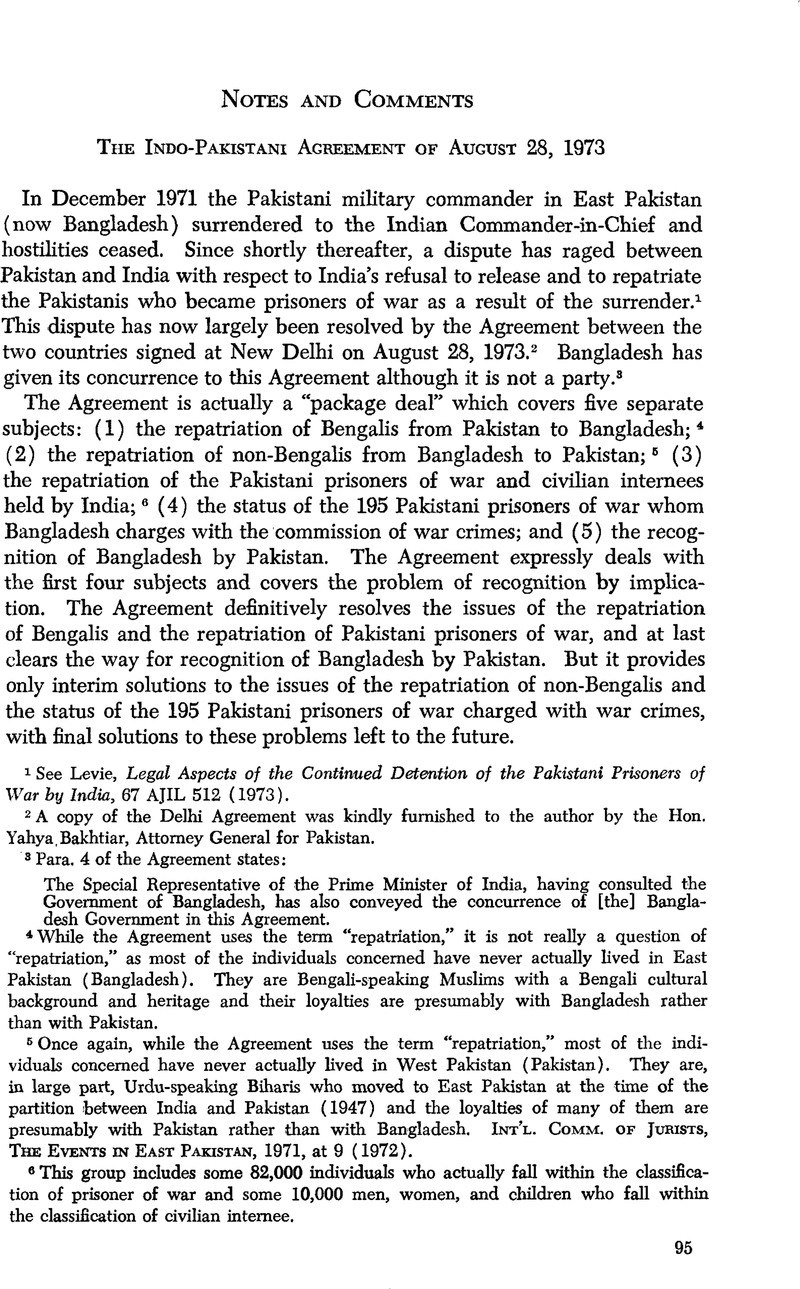Article contents
The Indo-Pakistani Agreement of August 28, 1973
Published online by Cambridge University Press: 28 March 2017
Abstract

- Type
- Notes and Comments
- Information
- Copyright
- Copyright © American Society of International Law 1974
References
1 See Levie, , Legal Aspects of the Continued Detention of the Pakistani Prisoners of War by India, 67 AJIL 512 (1973)Google Scholar.
2 A copy of the Delhi Agreement was kindly furnished to the author by the Hon. Yahya Bakhtiar, Attorney General for Pakistan.
3 Para. 4 of the Agreement states:
The Special Representative of the Prime Minister of India, having consulted the Government of Bangladesh, has also conveyed the concurrence of [the] Bangladesh Government in this Agreement.
4 While the Agreement uses the term “repatriation,” it is not really a question of “repatriation,” as most of the individuals concerned have never actually lived in East Pakistan (Bangladesh). They are Bengali-speaking Muslims with a Bengali cultural background and heritage and their loyalties are presumably with Bangladesh rather than with Pakistan.
5 Once again, while the Agreement uses the term “repatriation,” most of the individuals concerned have never actually lived in West Pakistan (Pakistan). They are, in large part, Urdu-speaking Biharis who moved to East Pakistan at the time of the partition between India and Pakistan (1947) and the loyalties of many of them are presumably with Pakistan rather than with Bangladesh. Int’l. Comm. of Jurists, The events in East Pakistan, 1971, at 9 (1972).
6 This group includes some 82,000 individuals who actually fall within the classification of prisoner of war and some 10,000 men, women, and children who fall within the classification of civilian internee.
7 N.Y. Times, April 18, 1973, at 1, c. 1.
8 Despite a flagging economy and existing population problems, in 1964 East Pakistan already had a population density of 922 persons per square mile, higher than the population density of Japan! Weekes, , Pakistan: Birth and Growth of a Muslim Nation 7 (1964)Google Scholar), Bangladesh is apparently prepared to accept all of these Bengalis and anticipates that all of them will desire to make that country their home. The Agreement does not even provide an option for these individuals as it does in the converse situation.
9 N.Y. Times, April 18, 1973, at 1, c. 1.
10 There have also been indications that Pakistan doubts the bona fides of many of the individuals who would be included in this mass movement into its territory.
11 75 UNTS 135; 6 USTS 3316; 47 AJIL SUPP. 119 (1953). For a discussion of India’s default, see Levie, supra note 1.
12 On May 11, 1973, Pakistan instituted proceedings against India in the International Court of Justice with respect to these 195 prisoners of war (Case Concerning Trial of Pakistani Prisoners of War). At Pakistan’s request the case was removed from the Court’s list on Dec. 15, 1973.
13 On Sept. 20, 1973, in a speech to the UN General Assembly, Prime Minister Bhutto stated that Pakistan would not oppose the admission of Bangladesh to the United Nations once all Pakistani prisoners of war, including the 195 held for possible trial, had been repatriated. UN Press Release WS/625, Sept, 21, 1973, at 3.
- 2
- Cited by




